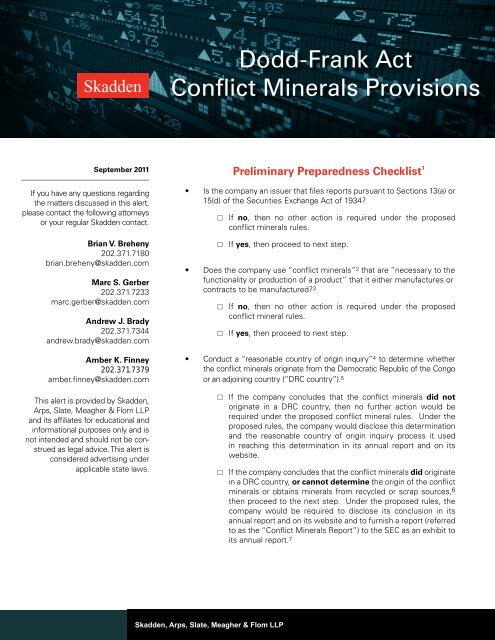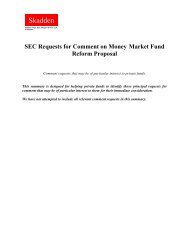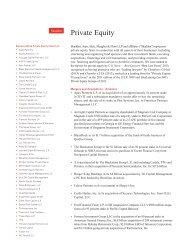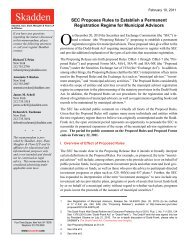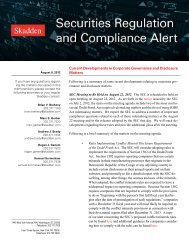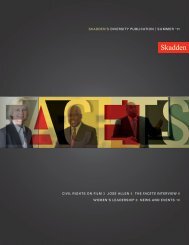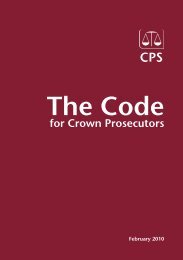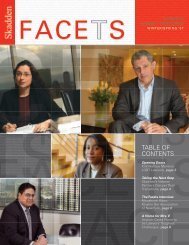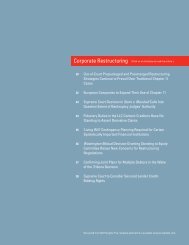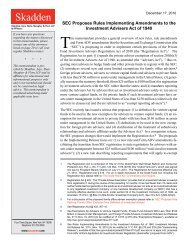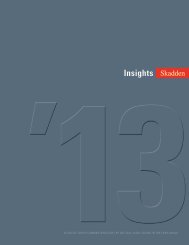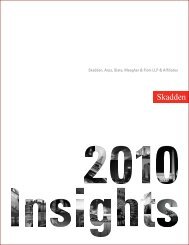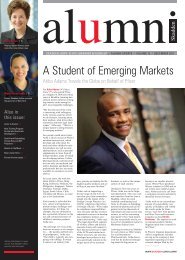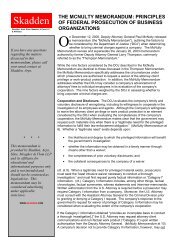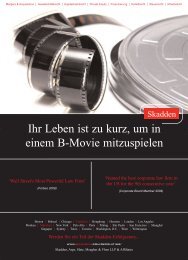Dodd-Frank Act Conflict Minerals Provisions - Skadden
Dodd-Frank Act Conflict Minerals Provisions - Skadden
Dodd-Frank Act Conflict Minerals Provisions - Skadden
You also want an ePaper? Increase the reach of your titles
YUMPU automatically turns print PDFs into web optimized ePapers that Google loves.
<strong>Dodd</strong>-<strong>Frank</strong> <strong>Act</strong> <strong>Conflict</strong> <strong>Minerals</strong> <strong>Provisions</strong> September 2011<br />
<strong>Dodd</strong>-<strong>Frank</strong> <strong>Act</strong><br />
<strong>Conflict</strong> <strong>Minerals</strong> <strong>Provisions</strong><br />
September 2011<br />
If you have any questions regarding<br />
the matters discussed in this alert,<br />
please contact the following attorneys<br />
or your regular <strong>Skadden</strong> contact.<br />
Brian V. Breheny<br />
202.371.7180<br />
brian.breheny@skadden.com<br />
Marc S. Gerber<br />
202.371.7233<br />
marc.gerber@skadden.com<br />
Andrew J. Brady<br />
202.371.7344<br />
andrew.brady@skadden.com<br />
Amber K. Finney<br />
202.371.7379<br />
amber.finney@skadden.com<br />
This alert is provided by <strong>Skadden</strong>,<br />
Arps, Slate, Meagher & Flom LLP<br />
and its affiliates for educational and<br />
informational purposes only and is<br />
not intended and should not be construed<br />
as legal advice. This alert is<br />
considered advertising under<br />
applicable state laws.<br />
Preliminary Preparedness Checklist 1<br />
• Is the company an issuer that files reports pursuant to Sections 13(a) or<br />
15(d) of the Securities Exchange <strong>Act</strong> of 1934?<br />
□ If no, then no other action is required under the proposed<br />
conflict minerals rules.<br />
□ If yes, then proceed to next step.<br />
• Does the company use “conflict minerals” 2 that are “necessary to the<br />
functionality or production of a product” that it either manufactures or<br />
contracts to be manufactured? 3<br />
□ If no, then no other action is required under the proposed<br />
conflict mineral rules.<br />
□ If yes, then proceed to next step.<br />
• Conduct a “reasonable country of origin inquiry” 4 to determine whether<br />
the conflict minerals originate from the Democratic Republic of the Congo<br />
or an adjoining country (“DRC country”). 5<br />
□ If the company concludes that the conflict minerals did not<br />
originate in a DRC country, then no further action would be<br />
required under the proposed conflict mineral rules. Under the<br />
proposed rules, the company would disclose this determination<br />
and the reasonable country of origin inquiry process it used<br />
in reaching this determination in its annual report and on its<br />
website.<br />
□ If the company concludes that the conflict minerals did originate<br />
in a DRC country, or cannot determine the origin of the conflict<br />
minerals or obtains minerals from recycled or scrap sources, 6<br />
then proceed to the next step. Under the proposed rules, the<br />
company would be required to disclose its conclusion in its<br />
annual report and on its website and to furnish a report (referred<br />
to as the “<strong>Conflict</strong> <strong>Minerals</strong> Report”) to the SEC as an exhibit to<br />
its annual report. 7<br />
<strong>Skadden</strong>, Arps, Slate, Meagher & Flom LLP
2<br />
<strong>Dodd</strong>-<strong>Frank</strong> <strong>Act</strong> <strong>Conflict</strong> <strong>Minerals</strong> <strong>Provisions</strong> September 2011<br />
• Establish supply chain due diligence process. 8<br />
□ Identify the suppliers or manufacturers who supply conflict minerals or products<br />
containing conflict minerals and the source of such conflict minerals. 9<br />
□ Determine whether the conflict minerals are used to “directly or indirectly finance or<br />
benefit armed groups.”<br />
2<br />
□ Establish a record-keeping process and policies for maintaining this information.<br />
□ Consider establishing record-keeping policies, procedures and/or conflict mineral<br />
standards with suppliers and manufacturers.<br />
• Identify a third-party independent auditor that will conduct and certify an independent private<br />
sector audit.<br />
• Prepare <strong>Conflict</strong> <strong>Minerals</strong> Report.<br />
ENDNOTES:<br />
1 This checklist was prepared based on the conflict minerals rules proposed by the SEC on December 15,<br />
2010 (http://www.sec.gov/rules/proposed/2010/34-63547.pdf) to implement Section 1502 of the <strong>Dodd</strong>-<strong>Frank</strong><br />
<strong>Act</strong>. The SEC will need to adopt final rules before the conflict minerals provisions become effective. Those<br />
final SEC rules are expected to be adopted before December 31, 2011.<br />
2 “<strong>Conflict</strong> minerals” is defined in Section 1502(e)(4) of the <strong>Dodd</strong>-<strong>Frank</strong> <strong>Act</strong> as “(A) columbite-tantalite, also<br />
known as coltan (the metal ore from which tantalum is extracted); cassiterite (the metal ore from which tin<br />
is extracted); gold; wolframite (the metal ore from which tungsten is extracted); or their derivatives; or (B)<br />
any other mineral or its derivatives determined by the Secretary of State to be financing conflict in the DRC<br />
countries [defined below].” These materials are commonly found in such products as jewelry, computers,<br />
mobile telephones, digital cameras, videogame consoles, and electronic and communications equipment.<br />
3 In a comment letter submitted by Senator Richard J. Durbin and Representative Jim McDermott to the<br />
SEC on its proposed conflict minerals rules, the Congressmen stated that the conflict mineral rules should<br />
“exempt pure retailers” who sell products over which retailers have no influence regarding their manufacture<br />
(i.e., third-party products). The Congressmen asserted that companies that contract for the manufacturing<br />
of products over which they have any influence regarding the manufacturing of those products would be<br />
subject to the conflict mineral rules. Additionally, the Congressmen stated that the conflict mineral rules<br />
were intended to apply to companies selling generic products under their own brand name or a separate<br />
brand name that they have established, regardless of whether such companies have any influence over the<br />
manufacturing specifications of those products, as long as such company has contracted with another party<br />
to have the product manufactured specifically for such company.<br />
4 The SEC did not propose rules setting forth the steps required to satisfy the reasonable inquiry standard.<br />
The SEC did note, however, that an inquiry would be based on the facts and circumstances of each company<br />
and that the standard would not require absolute certainty.<br />
5 Countries that adjoin the Democratic Republic of the Congo include Angola, Burundi, the Central African<br />
Republic, the Republic of Congo (a separate country from the Democratic Republic of the Congo), Rwanda,<br />
Sudan, Tanzania, Uganda and Zambia.<br />
6 If companies obtain conflict minerals from recycled or scrap sources, then such company may consider<br />
the minerals to be “DRC conflict free” and would furnish a <strong>Conflict</strong> <strong>Minerals</strong> Report subject to special<br />
rules. Under the proposed rules, conflict minerals that are “reclaimed end-user or post-consumer products”<br />
would be considered “recycled,” but if such materials are partially processed, unprocessed, or a byproduct<br />
from another ore, then such materials would not be considered “recycled.”<br />
2<br />
<strong>Skadden</strong>, Arps, Slate, Meagher & Flom LLP
3<br />
<strong>Dodd</strong>-<strong>Frank</strong> <strong>Act</strong> <strong>Conflict</strong> <strong>Minerals</strong> <strong>Provisions</strong> September 2011<br />
7 The proposed conflict minerals rules include specific disclosure requirements for the <strong>Conflict</strong> <strong>Minerals</strong><br />
Report, including a description of the measures taken by the company to exercise due diligence on the<br />
source and chain of custody of its conflict minerals. These due diligence measures would include, but would<br />
not be limited to, an independent private sector audit of the company’s report conducted in accordance with<br />
standards established by the comptroller general of the United States.<br />
8 On July 15, 2011, the U.S. Department of State issued a statement encouraging companies to “begin<br />
immediately to structure their supply chain relationships in a responsible and productive manner to<br />
encourage legitimate, conflict-free trade, including conflict-free minerals sourced from the DRC and the<br />
Great Lakes region.” The State Department noted that starting this process immediately would “facilitate<br />
useful disclosures under Section 1502 . . . .” A copy of the statement can be found at: http://www.state.<br />
gov/e/eeb/diamonds/docs/168632.htm.<br />
9 Due diligence should include a description of products, the facilities used to process the conflict minerals,<br />
and the mine or location of origin of those conflict minerals. In its July 2011 statement referenced above,<br />
the State Department endorsed “the guidance issued by the Organisation for Economic Co-operation and<br />
Development (OECD) and encourage[d] companies to draw upon this guidance as they establish their due<br />
diligence practices” and encouraged “companies, whether or not they are subject to the Section 1502<br />
disclosure requirement, that are within the supply chain of these minerals to exercise due diligence based<br />
on the OECD guidance and framework as a means of responding to requests from subject suppliers and<br />
customers.” A copy of the OECD’s “Due Diligence Guidance for Responsible Supply Chains of <strong>Minerals</strong> from<br />
<strong>Conflict</strong>-Affected and High-Risk Areas” can be found at: http://www.oecd.org/dataoecd/62/30/46740847.<br />
pdf. There have been recent reports, however, that the OECD has launched a pilot program to review<br />
and revise its conflict minerals guidelines in response to complaints by companies that the guidelines<br />
are difficult to use and may not meet the requirements of the SEC’s rules. For additional information<br />
see: http://www.ipc.org/ContentPage.aspx?pageid=IPC-Invited-to-Participate-in-Pilot-Evaluation-of-OECD-<br />
<strong>Conflict</strong>-<strong>Minerals</strong>-Due-Diligence-Guide.<br />
3<br />
<strong>Skadden</strong>, Arps, Slate, Meagher & Flom LLP


